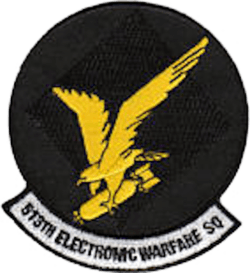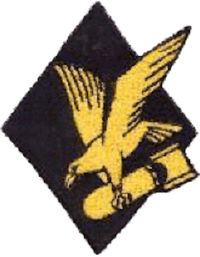513th Electronic Warfare Squadron
| 513th Electronic Warfare Squadron | |
|---|---|
_Lockheed_Martin_F-35A_Lightning_II_09-5007_(15568389597).jpg) 53d Wing F-35A Lightning II at Eglin AFB | |
| Active | 1942-1965; 1986-1997; 2010-present |
| Country |
|
| Branch |
|
| Role | Electronic Warfare |
| Part of | Air Combat Command |
| Garrison/HQ | Eglin Air Force Base |
| Engagements | Mediterranean Theater of Operations[1] |
| Decorations |
Distinguished Unit Citation Air Force Outstanding Unit Award Air Force Organizational Excellence Award[1] |
| Insignia | |
| 513th Electronic Warfare Squadron emblem (approved 12 July 1994)[1] |
 |
| 513th Test Squadron emblem (approved 1989) [2] |
 |
| 513th Bombardment Squadron emblem (approved 6 January 1944)[3] |
 |
The 513th Electronic Warfare Squadron is a United States Air Force unit assigned to the 53d Electronic Warfare Group, stationed at Eglin Air Force Base, Florida.
Mission
The 513th Electronic Warfare Squadron is a joint-service unit, and will serve as the sole Department of Defense provider of electronic warfare support for the F-35 joint strike fighter. It will operate the $300 million United States Reprogramming Laboratory, that tests all aspects of the joint strike fighter's electronic warfare capability. Half of the staff will be Airmen, while the other half will consist of Navy and Marine members.
History
World War II
Established in the Middle East during late 1942[1] to aid British Forces during the Western Desert Campaign. Initially equipped with obsolescent Boeing B-17C Flying Fortresses transferred from Tenth Air Force. Replaced with Consolidated B-24 Liberators flown from Florida via South America; over to then across Central Africa then north to Egypt in early 1943. Became part of United States Middle East Air Forces, later Ninth Air Force.
Operating from bases in Palestine, Egypt, Libya and Tunisia, attacked shipping in the Mediterranean and harbor installations in Libya, Tunisia, Sicily, and Italy to cut enemy supply lines to North Africa. Struck airdromes, marshalling yards, and other objectives in Sicily and Italy after the fall of Tunisia in May 1943. Reassigned to Fifteenth Air Force in late 1943, and moved to southern Italy. Squadron flew long range strategic bombardment missions to targets in Italy, France, Germany, Czechoslovakia, Austria, Hungary, and the Balkans to bomb factories, marshalling yards, oil refineries, oil storage facilities, airdromes, bridges, harbors, and other objectives.
After the German Capitulation in May 1945, returned to the United States; was re-equipped with Boeing B-29 Superfortress bombers and trained under Second Air Force for deployment to the Pacific Theater. However, with the Japanese Capitulation in August, the training ended and most personnel demobilized by the end of October. Remained in active status but not fully manned or equipped after November 1945, and subsequently inactivated in March 1946.[1]
Weather reconnaissance
The squadron was activated as the 513th Reconnaissance Squadron, Very Long Range, Weather on 23 May 1947 but was not manned or equipped, and was inactivated 20 Sep 1948.[1] It was again active as a weather reconnaissance unit from 1949 until 1951.
Strategic Air Command bombardment operations
Practiced electronic countermeasures with B-29 aircraft from c. 1952 until conversion to Boeing B-47 Stratojet jet medium bombers in 1954. Between 1954 and 1965, the 513th Bombardment Squadron flew a long series of simulated combat bombardment missions to maintain readiness as a unit of the Strategic Air Command, testing electronic warfare devices and radar techniques, using B-47 and EB-47 aircraft. Inactivated in 1965 with the retirement of the B-47.[1]
Operational test unit
Between 1987 and 1997, conducted operational test and evaluation of Boeing B-52 Stratofortress, Rockwell B-1 Lancer, and Boeing KC-135 Stratotanker aircraft and support systems.
Electronic warfare for F-35
Activated in April 2010 with an electronic warfare mission, reprogramming the F-35.[1]
Lineage
- Constituted as the 513th Bombardment Squadron (Heavy) on 19 October 1942
- Activated on 31 October 1942
- Redesignated 513th Bombardment Squadron, Heavy on 3 May 1944
- Redesignated 513th Bombardment Squadron, Very Heavy on 23 May 1945
- Inactivated on 31 March 1946
- Redesignated 513th Reconnaissance Squadron, Very Long Range, Weather on 6 May 1947
- Activated on 23 May 1947
- Inactivated on 20 September 1948
- Activated on 10 August 1949
- Inactivated on 20 February 1951
- Redesignated 513th Bombardment Squadron, Medium on 25 May 1951
- Activated on 1 June 1951
- Discontinued and inactivated on 15 March 1965
- Redesignated 513th Test Squadron on 12 February 1986
- Activated on 1 July 1986
- Redesignated 513th Engineering and Test Squadron on 15 April 1993
- Inactivated on 31 May 1997
- Redesignated 513th Electronic Warfare Squadron on 30 March 2010
- Activated on 23 April 2010[1]
Assignments
- 376th Bombardment Group, 31 October 1942
- 497th Bombardment Group, 1 November 1945 – 31 March 1946
- 376th Reconnaissance Group, 23 May 1947
- Air Weather Service, 26 September 1947
- 308th Reconnaissance Group, 14 October 1947 – 20 Sep 1948
- 308th Reconnaissance Group, 10 August 1949
- Air Weather Service, 19 December 1950 – 20 Feb 1951
- 376th Bombardment Group, 1 June 1951
- 376th Bombardment Wing, 16 June 1952 – 15 March 1965
- Strategic Air Command, 1 July 1986 – 1 June 1992 (attached to SAC Combat Operations Staff)
- USAF Air Warfare Center, 1 June 1992
- 68th Electronic Combat Group, 15 April 1993 – 31 May 1997
- 53d Electronic Warfare Group, 23 April 2010 – present[1]
Stations
|
|
Aircraft
- Boeing B-17 Flying Fortress, 1942-1943
- Consolidated B-24 Liberator, 1943-1945
- Boeing B-29 Superfortress, 1945, 1951-1954; B/RB/WB-29, 1950-1951
- Boeing B-47 Stratojet, 1954-1961
- Boeing EB-47 Stratojet, 1961-1965
- Boeing B-52 Stratofortress, 1992-1997
- Rockwell B-1 Lancer, 1992-1997
- Boeing KC-135 Stratotanker, 1992-1997
- Lockheed Martin F-35 Lightning II, 2010–present[1]
References
Notes
- 1 2 3 4 5 6 7 8 9 10 11 12 Kane, Robert B. (May 20, 2010). "Factsheet 513 Electronic Warfare Squadron (ACC)". Air Force Historical Research Agency. Retrieved April 3, 2018.
- ↑ "Approved insignia for: 513th Test Squadron". from National Archives Catalog. 1989. Retrieved April 3, 2018.
- ↑ Maurer, Combat Squadrons, pp. 617-618
Bibliography
![]()
- Maurer, Maurer, ed. (1983) [1961]. Air Force Combat Units of World War II (PDF) (reprint ed.). Washington, DC: Office of Air Force History. ISBN 0-912799-02-1. LCCN 61060979. Retrieved December 17, 2016.
- Maurer, Maurer, ed. (1982) [1969]. Combat Squadrons of the Air Force, World War II (PDF) (reprint ed.). Washington, DC: Office of Air Force History. ISBN 0-405-12194-6. LCCN 70605402. OCLC 72556. Retrieved December 17, 2016.
- Ravenstein, Charles A. (1984). Air Force Combat Wings, Lineage & Honors Histories 1947-1977 (PDF). Washington, DC: Office of Air Force History. ISBN 0-912799-12-9. Retrieved December 17, 2016.
,
